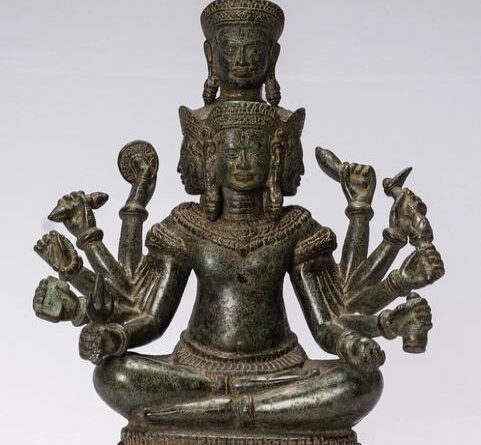The Gurur Brahmā chant – gratitude to the guru
By Vula Bolou, BSc, MSc, CIYT(Level 3)
The Gurur Brahmā chant1 comes with unspoken relief for the beginner yoga student at the onset of a class. After the varied rhythm and largely unknown vocabulary of the invocation to Patañjali, the Gurur Brahmā chant, short and full of familiarity, soothes and reassures a worried, unsure mind.
The word guru needs no introduction – spiritual matters might claim exclusivity to the term, however, nowadays all human endeavour (from computer programming to restaurants) seems to be in need of top-level guidance. The popularity of the term, however, cannot possibly affect its meaning in the spiritual realm: a teacher, whose impact to one’s life is so profound that inspires a deep-rooted love, gratitude and an unquestionable feeling of surrender.
Guru is a Sanskrit word, meaning, among others, ‘teacher’ as a noun, and also ‘heavy’ as an adjective, and by extrapolation ‘heavy with spiritual knowledge’ 2. In the Advayatāraka Upaniṣad (verse 16)3, we find the more well-known definition: “The syllable gu means darkness, the syllable ru, he who dispels it, because of the power to dispel darkness, the guru is thus named.” Darkness relates to ignorance, avidyā, a term which Patañjali defines in Sādhanā Pāda (P.Y.S. II.5) as “Mistaking the transient for the permanent, the impure for the pure, pain for pleasure and that which is not the self for the self: all this is called lack of spiritual knowledge, avidyā” 4.
Therefore, a guru is the person who removes this ignorance and assists the seeker in his or her journey to Self-realisation – hence the profound impact mentioned above.
To us, the students of Iyengar yoga, Guru or Guruji (-ji is a suffix to denote affectionate closeness) is a synonum for the pioneer of our yogic tradition and our very first teacher, B.K.S. Iyengar. Guruji Iyengar makes a clear distinction between a teacher and a guru5 and provides a link with God.
“Today, many people call themselves gurus, yogīs and yoginīs. This is wrong. Teachers should not be called gurus, and gurus are not to be merely seen as teachers. A guru is one who removes darkness and gives light. One who protects his or her pupils always so that they may not become victims of circumstances, and makes them work more and more so that they develop humility, is a guru. The role of the guru is to act as a bridge. Having experienced the truth, the guru is there as a bridge to help others towards God. The guru is an instrument of God, whose power moves in him or her, to shake those who do not yet understand the spiritual value of life and to bring them nearer to God.”
Hence, in the same way that the invocation to Patañjali is chanted to sanctify our practice6, it comes as no surprise that in the Gurur Brahmā chant that immediately follows it, one learns a bit more about the guru-God connection.
gurur brahmā gurur viṣṇu gurur devo maheśvaraḥ |
guruḥ sākṣāt para brahma tasmai śrī gurave namaḥ ||
A word-by-word translation from the Sanskrit follows7.
The guru is Brahmā (gurur brahmā), the guru is Viṣṇu (gurur viṣṇu), the guru is God (gurur devo) the supreme Lord (maheśvaraḥ) or the Guru is Śiva. The guru is indeed (guruḥ sākśāt) the ultimate brahman (para brahma). To this venerable guru I bow (tasmai śrī gurave namaḥ).
So, the guru is God in His three forms in Hindu thought, also called trimūrti (three faces). Brahmā is the Creator, Viṣṇu the Preserver and Śiva the Destroyer, hence covering all aspects of cosmic function as well as human endeavour. After identifying the trimūrti in the entity of a guru, the Gurur Brahmā chant goes one step further and equates the guru with the Absolute, para brahman. The guru then, is an embodiment of the Universal Spirit. Why is such an equation necessary? As the Bhagavad Gītā (XII.5)explains, “For those whose minds are attached to the unmanifest, the path of realization is full of tribulations. Worship of the unmanifest is exceedingly difficult for embodied beings.”8 Hence, the guru provides a form to assist the seeker on the path to Self-realisation. For all those reasons, respect is offered to the guru.
The Gurur Brahmā chant is not alone in this reverential tribute. The Taittirīya Upaniṣad (I.11.2) creates a broader environment of respect to incorporate other venerable persons, “Be one to whom the mother is a god, be one to whom the father is a god, be one to whom the teacher is a god, be one to whom the guest is a god”9 .
This exact notion however, finds the overthinking non-Hindu Westerner in search of a rational twist to the Gurur Brahmā chant: sure we honour all those people, but do we really need to bring God into this? Each tradition utilises tools relevant to its members, so, in another system of translation, where we invert the Guru chant in Śirṣāsana (i.e. on its head), what can we come up with?
The trimūrti represents God in His three forms, right? Brahmā, Viṣṇu and Śiva. In other words, Brahmā, as the Creator, may be considered the beginning of an activity or the birth of something, Viṣṇu, as the Preserver, can be thought of as the duration or the life itself of a being and Śiva, as the Destroyer, may signify the end or death of an activity or a being. Moreover, if to assign the qualities of a guru to a person seems too much of a commitment to those over-analyzers of earlier, we may call the specific aspect of the trimūrti of the second version not a guru, but a ‘learning experience’.
So, the chant advises that a student should make each moment of their lives (beginning, duration, end) a learning experience (gurur brahmā gurur viṣṇu | gurur devo maheśvaraḥ). They should learn here and now (guruḥ sākśāt) but also transcendentaly (para brahma). And this noble learning endeavour they should honour (tasmai śrī gurave namaḥ), i.e. make each moment of their lives an opportunity for learning and advancing on the path to Self-realisation. Now, isn’t this non-divine-mentioning version inclusive to all traditions?
One way or another, for us yoga practitioners and seekers on the spiritual path, the scriptures hold eternal truth – they are our guru.
———————————
- The term Gurur Brahmā chant denotes the third śloka of the thirteen-śloka Guru Stotram, a hymn to the guru. Here in its entirety https://sathyasaiwithstudents.blogspot.com/2014/06/shri-guru-stotram.html
- https://kosha.sanskrit.today/word/en/guru?q=guru
- https://en.wikipedia.org/wiki/Guru
- Iyengar, B.K.S. Light on the yoga sūtras of Patañjali, Thorsons, 1996 edition.(p. 108)
- Iyengar, B.K.S. The tree of yoga, Thorsons, (p. 141)
- Bolou, Vula, Iyengar Yoga News, IYA Winter 2023, (p.???)
- Vassiliades, Dimitrios. Notes from the Sanskrit classes, 2012-todate
- https://www.holy-bhagavad-gita.org/chapter/12/verse/5
- Radhakrishnan, S. The Principal Upaniṣads, Harper Collins, 2012. (p. 538)
This article first appeared in Iyengar Yoga News, Autumn 2023, issue 44.

